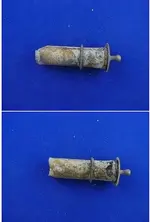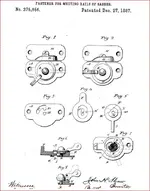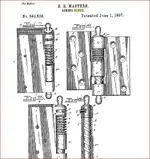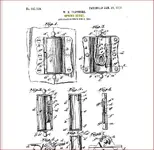I think it's finally starting to come together in my mind now thanks to the patent picure that was posted (thanks Matt!). This "object" (with the finial) is the decorative cap used to keep the rotating handle component in place (so it can only rotate along the vertical axis) that locks the sash. The handle component would theoretically consist of a single cast piece with a handle, a round disc with a hole in it that mates with the bevelled edge on this "object," and a "tongue" that would be secured by another stationary locking component which would be secured to the window. The shank of this "object" would be pinned to the stationary bracket that is screwed into the wooden sill--the pin is what keeps this "object" locked in place. The shank would have to protrude past the lowest part of the handle component to allow it to be pinned in place--which it does! The "lathe marks" that I see on the bevelled edge of the lip are actually metal-on-metal wear marks from the mating piece which the handle is attached to. The handle component is essentially the "female" part and this stationary "object" is the "male" part. I suppose this locking mechanism could have been used on a stagecoach, window, or something else and if the locking pin ever fell out this "object" would fall off (as would the rotating handle component--although this part would be much smaller and easier to lose) and that's when it was probably lost--either that or when these teapot sash locks were removed and replaced with something possibly more modern. Looks like most of them stem from ca. 1875 or so which gels with the age of this house. Sound reasonable?
Thank you to DCMatt for putting us in the right direction!



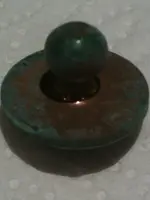
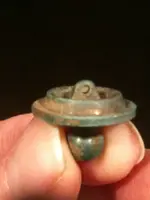
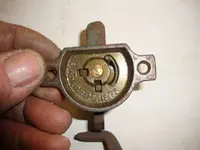

 I would love to see one of these disassembled as I think it would give us definitive proof. I'm still curious why the measurements we've taken on several different objects are identical. What I thought were mill marks could have been made by metal-on-metal contact this mechanism turned, though it doesn't really explain the marks on the edge of the disk. Pretty interesting stuff. Thanks Matt!
I would love to see one of these disassembled as I think it would give us definitive proof. I'm still curious why the measurements we've taken on several different objects are identical. What I thought were mill marks could have been made by metal-on-metal contact this mechanism turned, though it doesn't really explain the marks on the edge of the disk. Pretty interesting stuff. Thanks Matt!